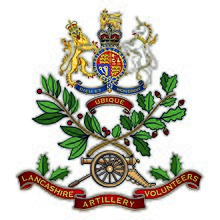103rd (Lancashire Artillery Volunteers) Regiment Royal Artillery
 From Wikipedia - Reading time: 8 min
From Wikipedia - Reading time: 8 min
| 103rd (Lancashire Artillery Volunteers) Regiment Royal Artillery | |
|---|---|
 The crest of 103 Regiment Royal Artillery | |
| Active | 1967 – present |
| Country | England |
| Allegiance | |
| Branch | |
| Type | Royal Artillery |
| Role | Field support |
| Size | 4 Batteries 432 personnel[1] |
| Part of | 4th Brigade |
| Garrison/HQ | Jubilee Barracks, St Helens |
| Nickname(s) | The North West Gunners / #TEAM103 |
| Motto(s) | Ubique – Everywhere.Quo Fas et Gloria Ducunt – Where Right and Glory Lead. |
| Colours | 105mm Light Gun – The Colours of the Royal Regiment of Artillery are its Guns or Weapon Systems. When on parade on Ceremonial occasions the Guns and Weapon Systems are to be accorded the same compliments as the Standards, Guidons and Colours of the Cavalry and Infantry. |
| March | The Royal Artillery Slow March |
| Anniversaries | 1 April 1967 |
| Equipment | L118 Light Gun |
| Insignia | |
| Cap Badge |  |
| Tactical Recognition Flash (TRF) |  |
| Tartan | Crawford (Pipers & Drummers kilts) |
103rd (Lancashire Artillery Volunteers) Regiment Royal Artillery is part of the Army Reserve and primarily has sub-units throughout the Greater Manchester and Merseyside area of the North-West of England, in recent years it has extended its footprint to Wolverhampton, Isle of Man, Carlisle and Nottingham. Its purpose is to provide reinforcements for units that use the 105 mm L118 Light Gun.
Formation
[edit]The Lancashire Artillery Volunteers were first raised in 1859 as part of the Volunteer Force raised in response to threats of French Invasion.[2] A total of 23 Artillery companies were raised initially. However, in Manchester, numerous units that would later form the Lancashire Artillery Gunners had existed from as early as 1804, when the Duke of Gloucester inspected the Heaton Artillery Volunteers before they were shipped off to the fronts of the Napoleonic Wars.[3]
20th Century History
[edit]Officers and men of the Lancashire Artillery Volunteers continued to give service during the two world wars of the 20th Century.[4]
In 1967, some of these units were amalgamated to form 103rd (Lancashire Artillery Volunteers) Light Air Defence Regiment Royal Artillery (Volunteers).[5] Its units were Headquarters Battery at Liverpool, 208 (3rd West Lancashire) Light Air Defence Battery at Liverpool and 209 (The Manchester Artillery) Light Air Defence Battery at Manchester.[5] In 1969 213 (South Lancashire Artillery) Light Air Defence Battery was formed at St Helens and joined the regiment.[5]
In 1976, the regiment changed its designation to 103rd (Lancashire Artillery Volunteers) Air Defence Regiment Royal Artillery (Volunteers) upon being equipped with the Blowpipe missile air-defense weapon.[5] Then, in 1986, 216 (The Bolton Artillery) Battery was formed at Bolton and joined the regiment.[5]
In 1992, as a result of the Options for Change, the regiment lost one Air-Defence Battery (213 Air-Defense Battery, which was amalgamated with HQ Battery at St Helens) and Regimental Headquarters were moved from Deysbrooke Barracks, Liverpool, to St. Helens to be co-located with HQ Battery.[5]
Modern day
[edit]In 2001, the regiment transferred from Air Defence to the Field Artillery as a Light Gun Regiment.[5]
Under Army 2020, 209 (Manchester & St Helens) Battery Royal Artillery increased to a battery size. 210 (Staffordshire) Battery Royal Artillery, based in Wolverhampton, joined this regiment from 106th (Yeomanry) Regiment Royal Artillery, and re-roled to a light gun battery. 103 Regiment is paired with the regular 4th Regiment RA under the 1st Artillery Brigade.[6][7]
The current structure of the regiment is as follows:[8][9]
- Regimental Headquarters, at Jubilee Barracks, Saint Helens[10]
- Headquarters Troop, at Jubilee Barracks, Saint Helens[10]
- 208 (3rd West Lancashire) Battery, at Brigadier Philip Toosy Barracks, Liverpool[12]
- Manx Troop, at Lord Street Army Reserve Centre, Douglas, Isle of Man[13] – formed in 2015[14]
- 209 (Manchester Artillery) Battery, at Belle Vue Street Army Reserve Centre, Manchester[15]
- 210 (Staffordshire) Battery, at Wolseley House, Wolverhampton[16][17]
- C (South Nottinghamshire Hussars, Royal Horse Artillery) Troop,[18][19] at Hucknall Lane Army Reserve Centre, Bulwell[20] – formed in 2018
- 216 (Bolton Artillery) Battery, at Nelson Street Army Reserve Centre, Bolton[11]
- Lancashire Artillery Pipes and Drums[10]
Equipment
[edit]The 103rd Regiment is equipped with the 105mm Light Gun, a versatile, air-portable and air-mobile artillery piece.[21]
Freedoms
[edit]The regiment has received the freedom of several locations throughout its history; these include:
 14 October 2017: Liverpool (208 (3rd West Lancashire) Battery).[22]
14 October 2017: Liverpool (208 (3rd West Lancashire) Battery).[22] 27 October 2020: Manchester (209 (Manchester Artillery) Battery).[23]
27 October 2020: Manchester (209 (Manchester Artillery) Battery).[23]
References
[edit]- ^ "Army – Question for Ministry of Defence". p. 1. Retrieved 14 December 2020.
- ^ "Sources for the history of the militia and volunteer regiments in Lancashire" (PDF). p. 18. Retrieved 11 May 2014.
- ^ "Salford Hundred ancestry, annals and history". Archived from the original on 3 March 2016. Retrieved 11 May 2014.
- ^ "British Artillery Officer's Sword to 2nd Lancashire Artillery Volunteers". Archived from the original on 13 May 2014. Retrieved 11 May 2014.
- ^ a b c d e f g "Royal Regiment of Artillery, Volunteer Regiments". Archived from the original on 12 December 2008. Retrieved 11 May 2014.
- ^ "Summary of Reserve Structure and Basing Changes, page 4" (PDF). Archived from the original (PDF) on 10 August 2013.
- ^ "Army 2020 Report, page 12" (PDF). Archived from the original (PDF) on 10 June 2014.
- ^ "Information regarding locations of Army Reserve units" (PDF). What do they know?. 6 July 2020. Archived (PDF) from the original on 6 July 2020. Retrieved 11 April 2021.
- ^ "103 Regiment Royal Artillery". www.army.mod.uk. Retrieved 13 April 2021.
- ^ a b c "Jubilee Barracks, Prescot Road, St Helens WA10 3UB". Army Careers. Retrieved 13 April 2021.
- ^ a b "Army Reserve Centre, Nelson Street, Bolton BL3 2RW". Army Careers. Retrieved 13 April 2021.
- ^ "Brigadier Philip Toosy Barracks, Aigburth Road, Liverpool L17 9PH". Army Careers. Retrieved 13 April 2021.
- ^ "Army Reserve Centre, Lord Street, Douglas, Isle of Man IM1 1LE". Army Careers. Retrieved 13 April 2021.
- ^ "Isle of Man Welcomes First Reserve Unit For 50 Years". Forces Network. 30 September 2015. Retrieved 27 August 2021.
- ^ "Army Reserve Centre, Belle Vue Street, Manchester M12 5PW". Army Careers. Retrieved 13 April 2021.
- ^ "Wolseley House, Fallings Park, Wolverhampton WV10 9QR". Army Careers. Retrieved 13 April 2021.
- ^ "Saragarhi Day 2021 commemorated in Wolverhampton". www.army.mod.uk. Retrieved 12 September 2021.
- ^ "The Royal Lancers and Nottinghamshire Yeomanry Museum". Retrieved 25 July 2020.
- ^ "C Troop celebrates a year in Nottingham". Retrieved 25 July 2020.
- ^ "Army Reserve Centre 221 Hucknall Lane, Bulwell, Nottingham NG6 8AQ". Army Careers. Retrieved 13 April 2021.
- ^ "105mm Light Gun Restoration". North East Military Motor Club. Archived from the original on 4 June 2019. Retrieved 4 June 2019.
- ^ "Army Battery awarded Freedom of Liverpool". ITV News. 16 October 2017.
- ^ Griffiths, Niall (27 October 2020). "Marcus Rashford should be awarded freedom of Manchester, says councillor". Manchester Evening News.
Publications
[edit]- Litchfield, Norman E H, and Westlake, R, 1982. The Volunteer Artillery 1859-1908, The Sherwood Press, Nottingham. ISBN 978-0-9508205-0-7
- Litchfield, Norman E H, 1992. The Territorial Artillery 1908-1988, The Sherwood Press, Nottingham. ISBN 978-0-9508205-2-1
 KSF
KSF